This post may contain affiliate links. Please read our disclosure policy.
This is the BEST Thanksgiving Turkey Recipe, packed with all the flavor and juiciness you crave—without any of the stress! I’ve got you covered with an easy, step-by-step guide to roasting a turkey that turns out perfectly every time.
Not only is this recipe simple and foolproof, but it’s also guaranteed to wow your guests and be the shining centerpiece of your Thanksgiving table!
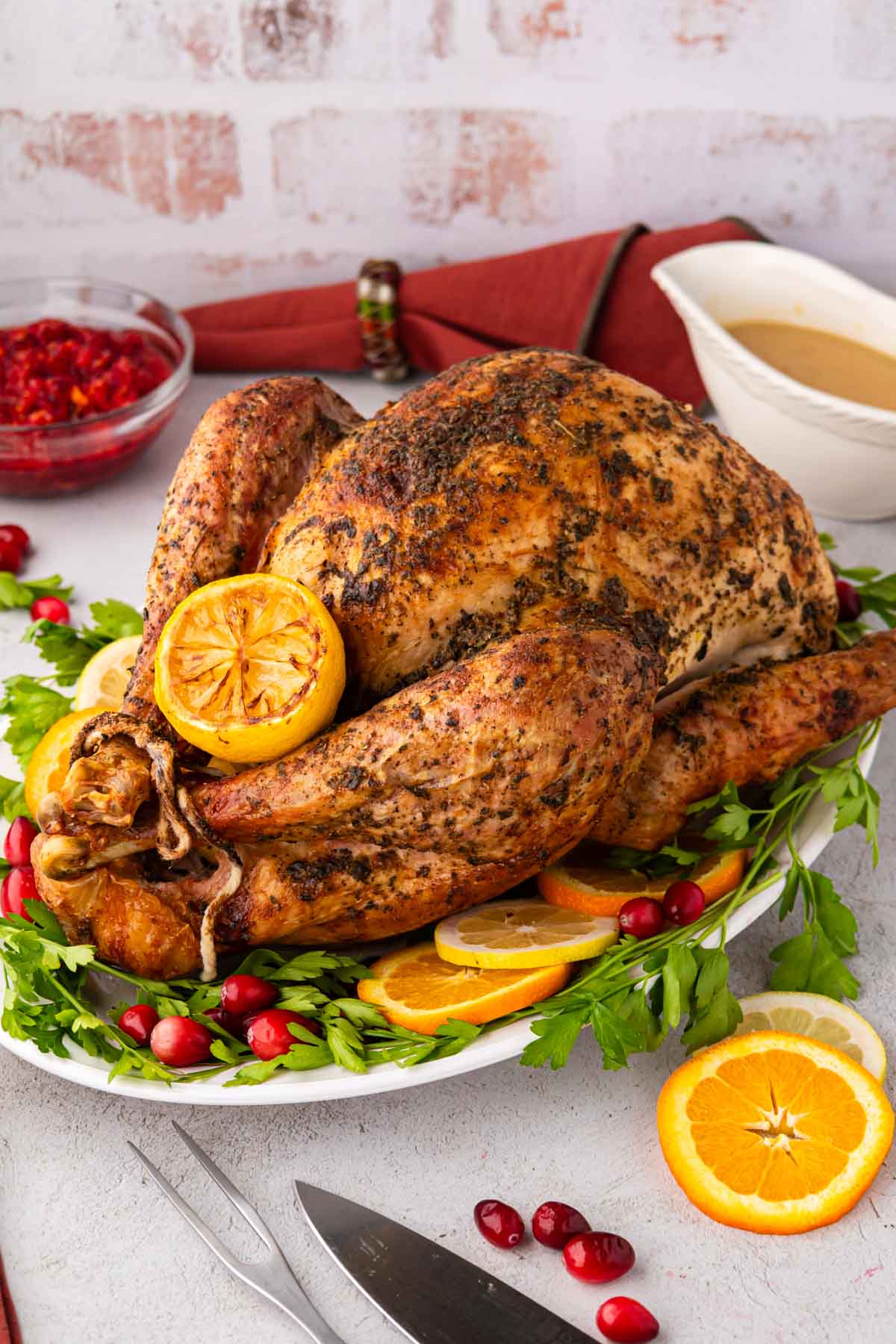
Nikki’s Recipe Rundown
- Taste: Packed with classic Thanksgiving flavors—herb butter gives it richness, while the aromatics add a fresh, light note. Super flavorful and delicious!
- Texture: Crisp, golden skin with juicy, tender meat. Both dark and white meat turn out perfectly moist without drying out.
- Ease: So simple! No basting or flipping is required. It’s beginner-friendly and stress-free, making it easy for anyone to nail a holiday turkey.
- Pros: Low effort with impressive results. No need for special equipment, and the steps are straightforward.
- Considerations: Use a meat thermometer to avoid overcooking. If the turkey is frozen, plan ahead for thawing time.
- Recipe Repeatability: Definitely a yearly go-to! It’s reliable and flexible enough to play with flavors, making it perfect for any Thanksgiving feast.
Juicy Roasted Turkey
Why do so many people stress over cooking the perfect Thanksgiving turkey? I get it—it’s the star of the show, and with a table full of loved ones, the pressure is on. But here’s the thing: it doesn’t have to be complicated or stressful!
My goal is to help ease any fears you may have about preparing a beautiful Christmas or Thanksgiving turkey. This method is simple, fuss-free, and perfect for busy families (isn’t that all of us around the holidays). There’s no need for fancy tricks like brining, basting every 30 minutes, or flipping the turkey upside down. And you definitely don’t need to splurge on an expensive roasting pan.
In my 30-plus years of cooking for family and friends, I’ve learned that the key to a juicy, flavorful turkey is to avoid overcooking. That’s what causes it to dry out, and nobody wants that! With a bit of planning and following a few straightforward steps, you’ll end up with a perfectly cooked, golden-brown turkey—one that’s moist, tender, and full of flavor.
So, relax, take a deep breath, and enjoy the process. I promise this will be the easiest—and most delicious—Oven-Roasted Turkey you’ve ever made!
Ingredient Needed for An Oven Roasted Turkey
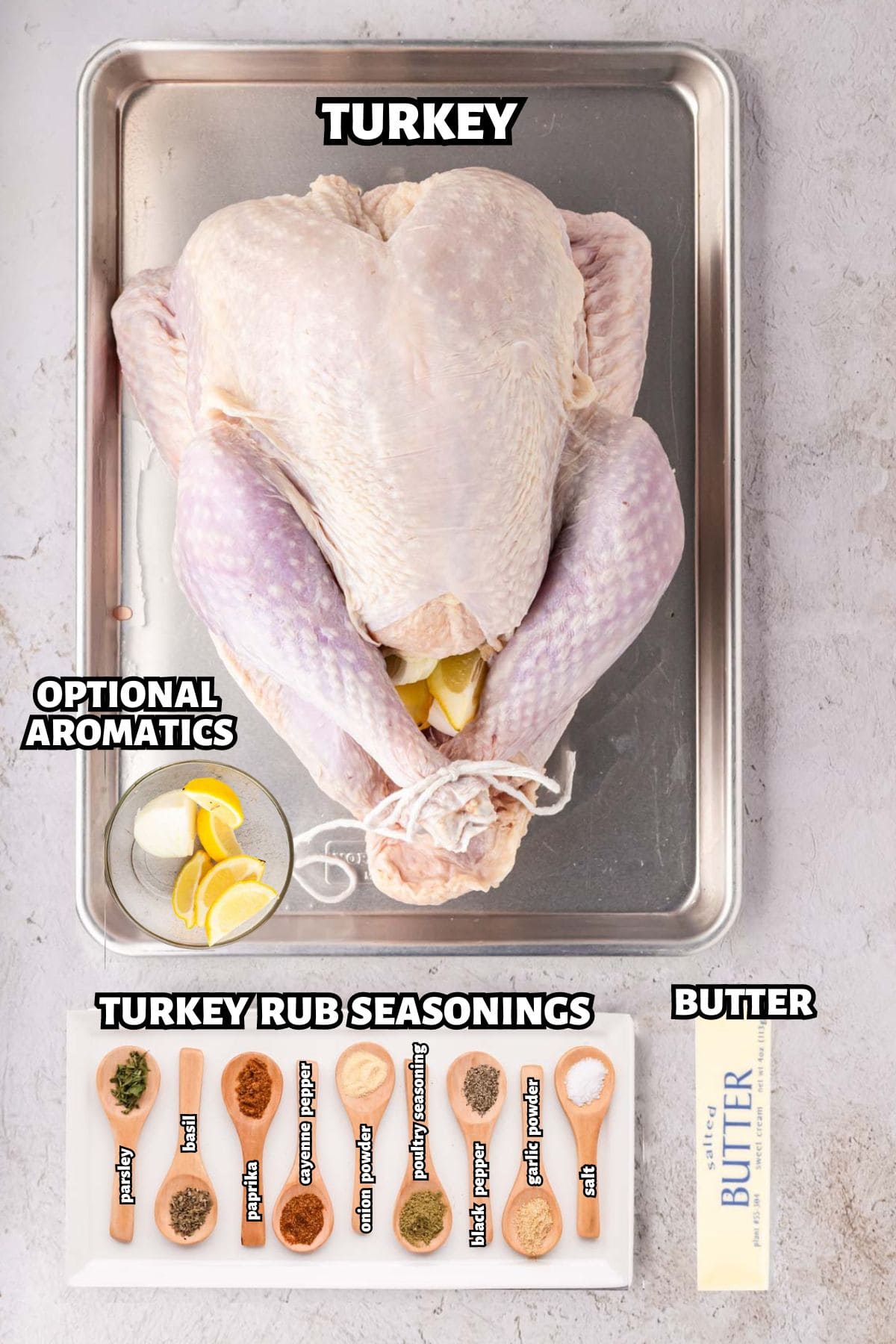
- Turkey: When selecting a turkey, you might come across terms like “young turkey.” A young turkey is typically less than 8 months old and tends to be more tender with better flavor, making it ideal for roasting. Most whole turkeys sold for Thanksgiving are young turkeys, whether fresh or frozen. Pay attention to one with a well-rounded breast—it will turn out juicier. Beware of flat spots, indicating the bird has been thawed and refrozen. I have had the best luck with Butterball Turkeys and my local Publix store brand.
- Butter: Use softened butter mixed with the seasonings to spread under the skin and on the outside for extra moisture and the crispiest turkey skin.
- Turkey Rub Seasoning: For the turkey seasoning, mix kosher salt, seasoned salt, ground pepper, poultry seasoning, garlic powder, paprika, and dried basil for a flavorful blend. Add red pepper for heat and finish with dried parsley for a touch of freshness. This seasoning mix creates a perfectly balanced and delicious turkey!
- Optional aromatics to add to the turkey cavity can really enhance flavor! I typically use lemon and onion wedges, but it’s entirely up to you. Other classics like garlic, apples, and celery are great for adding depth and richness, especially to the drippings for gravy. Feel free to mix and match based on your preferences to create your own signature flavor.
What Size Turkey to Buy
When deciding on the size of turkey to buy, plan for at least 1.5 pounds per person. This gives you enough for everyone at the table, plus some leftovers.
- If you’re feeding a small group of 4-6 people, a 10-12 pound turkey will do.
- For medium-sized gatherings (8-10 people), aim for a 12-16 pound turkey.
- If you’re serving a large group (12-14 people), go for a 16-20 pound bird. Opt for the larger end of these ranges if you want extra leftovers for the days after the feast!
How to Thaw a Frozen Turkey
Here are two safe methods for thawing a turkey:
- Refrigerator Thawing (Safest method):
- Place the turkey (still in its packaging) on a tray or in a pan to catch any drips.
- Allow 24 hours of thawing time for every 4-5 pounds of turkey.
- Example: A 12-pound turkey will take about 3 days to thaw.
- I usually give myself 1 extra day to be safe.
- Once thawed, the turkey can stay in the fridge for up to 2 days before cooking.
- Cold Water Thawing (Faster option):
- Keep the turkey in its packaging and submerge it in cold water, be sure it’s fully covered.
- Change the water every 30 minutes to keep it cold.
- Allow 30 minutes of thawing time per pound.
- Example: A 12-pound turkey will take about 6 hours to thaw this way.
- Cook the turkey immediately after thawing.
Never thaw a turkey on the countertop, as this can promote bacterial growth and make the turkey unsafe to eat.
Using a Disposable Pan to Roast a Turkey
If you don’t have a roasting pan and want to use a disposable pan, ball up pieces of foil to lift the turkey off the bottom of the pan. You can also place chopped veggies like celery, onions, and carrots at the bottom to act as a rack for the turkey. They’ll flavor the drippings for gravy, but I don’t recommend eating them or adding them to the gravy.
Turkey Cooking Time
When it comes to roasting your turkey, timing is key! You will need about 15 to 18 minutes (unstuffed) per pound for a perfect, juicy bird.
Want to Save this Recipe?
By submitting this form, you consent to receive emails from Soulfully Made.
How To Roast a Turkey in the Oven
✱ Be sure to see the recipe card below for exact ingredients and full recipe instructions!
Step 1 | Prep Turkey & Preheat Oven
Once thawed, let it sit out for about an hour before roasting to reach room temperature.
While the oven preheats to 325°F, prep the turkey by removing the giblets and neck from the cavity and patting it dry
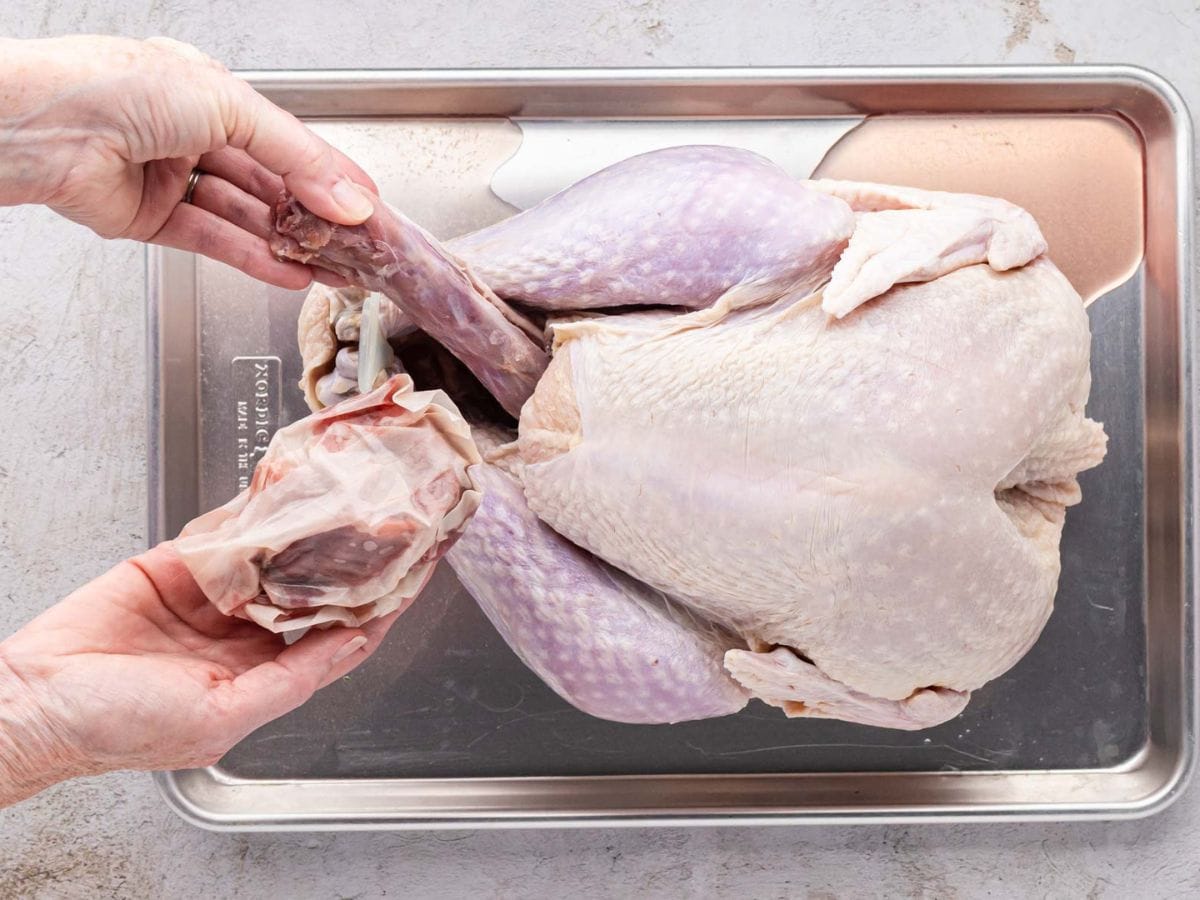
Step 2 | Season Turkey
Now, season under the skin and all over the turkey. To get under the skin, gently work your fingers between the breast meat and the skin, spreading about a third of the seasoning there.
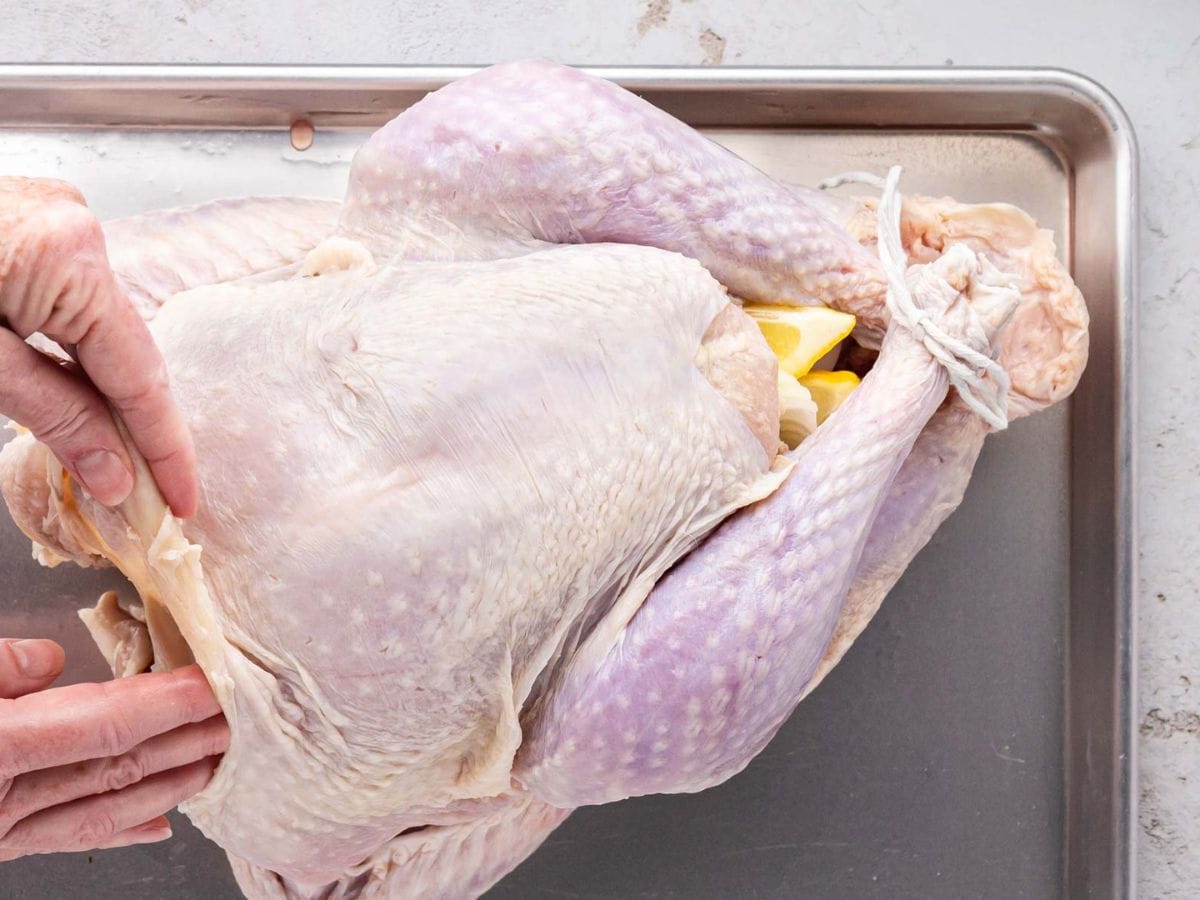
Then, mix the rest with softened butter and brush it all over the outside. If you prefer, you can rub the softened butter by hand instead.
Tie the legs with kitchen string and tuck the wings under the bird (this can be done before or after seasoning). If you tie it before, just be sure to be between the turkey’s legs and body.
Insert a meat thermometer into the lower part of the thigh, making sure not to touch the bone. Roast the turkey at 325°F, allowing about 15-18 minutes per pound.
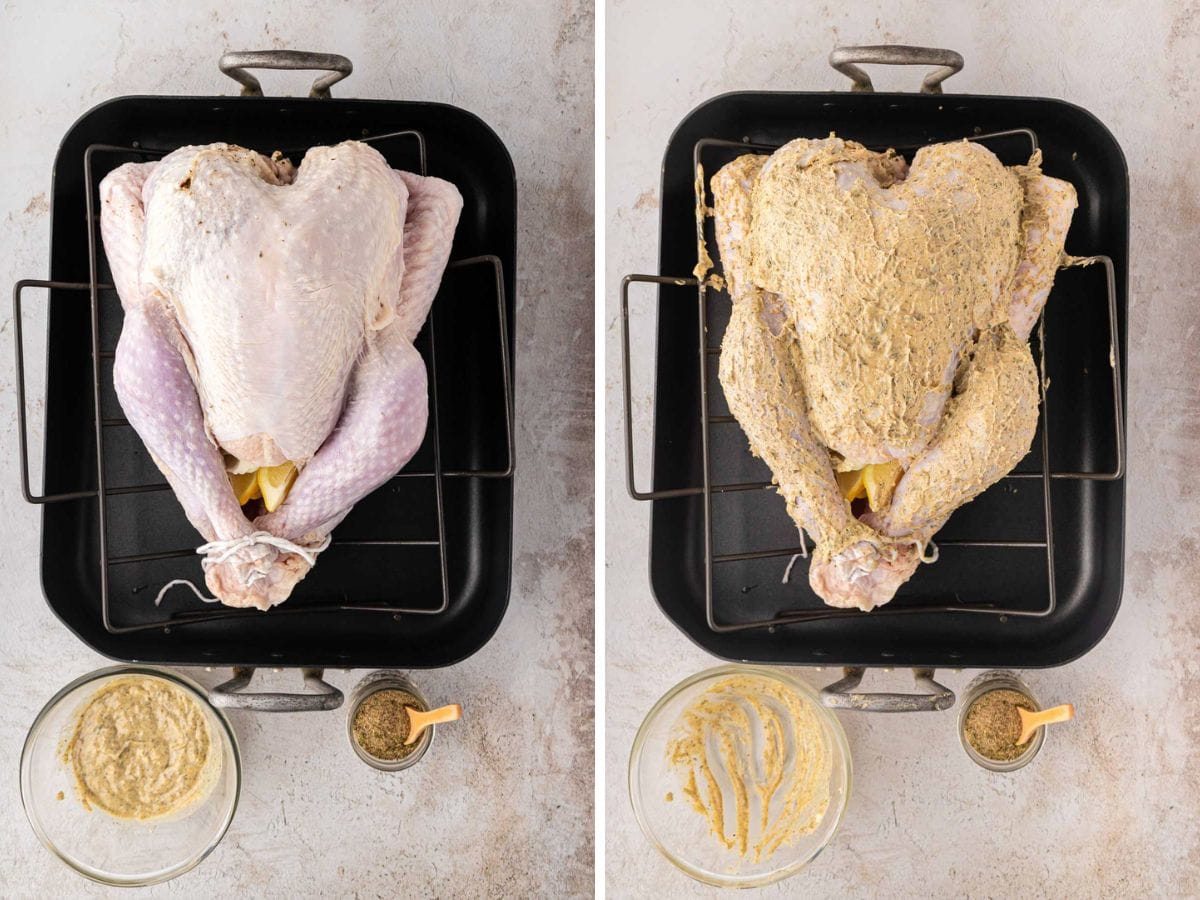
Step 3 | Bake Until You Have A Perfect Crispy Skin Roasted Turkey
Keep an eye on the bird! Once the skin turns golden brown, cover the top with foil to prevent the breast from overcooking.
When the internal temperature reaches 165°F, remove the turkey from the oven and let it rest for 20-30 minutes before carving.
Don’t forget to save those delicious pan drippings for turkey gravy!
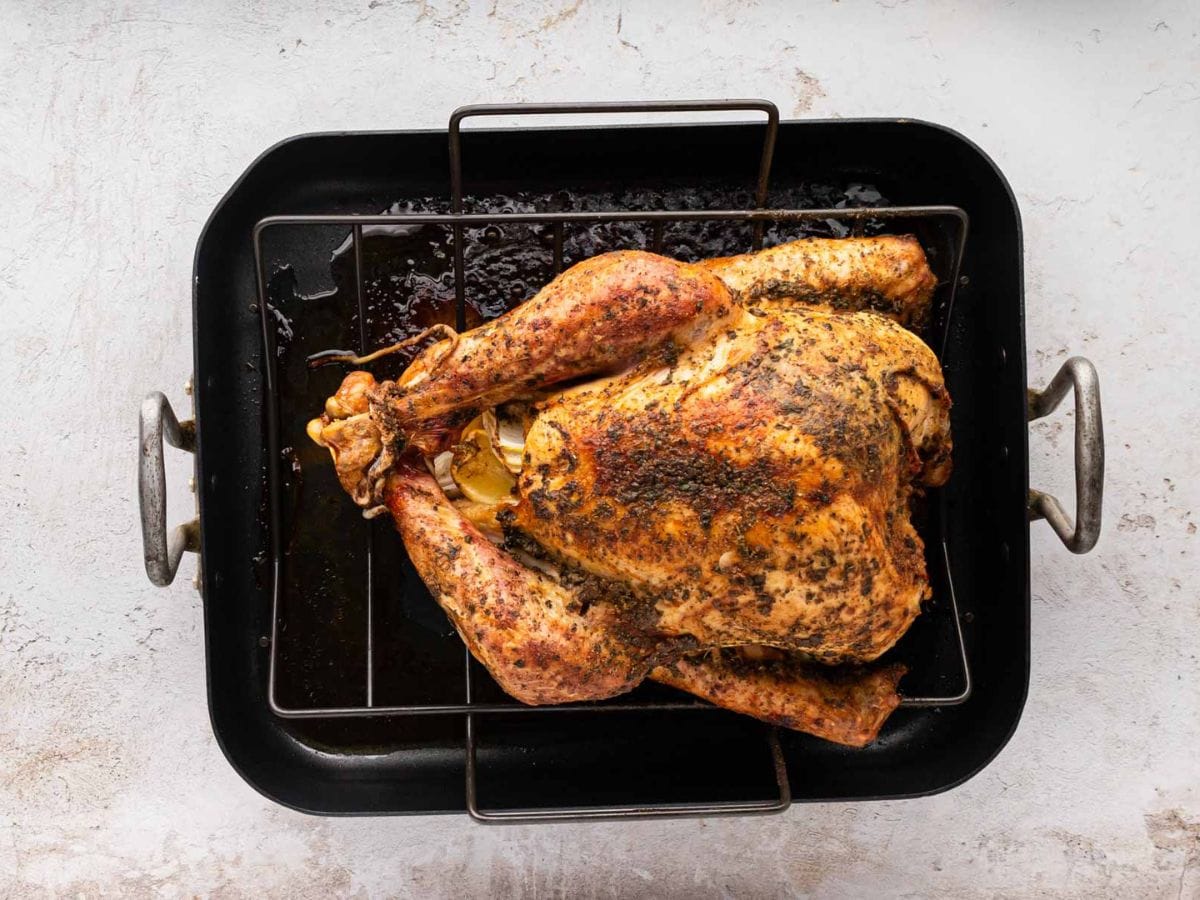
Turkey Roasting Tips
- Don’t Baste the Turkey: Basting requires opening the oven often, which lowers the temperature and increases cooking time. Rub the turkey with herb butter instead for a juicy, crispy skin without the hassle.
- Don’t Stuff the Turkey: Cooking stuffing inside extends the turkey’s cooking time, potentially drying out the meat. Make the stuffing separately to ensure both the turkey and stuffing cook evenly.
- No need to Brine the Turkey. For this simpler method, skip the brine and use our flavorful seasoned herb butter rub on the skin and under it for moisture and flavor without the extra step of brining.
- Covering with Foil: Start by roasting the turkey uncovered. Once the skin turns golden brown, loosely tent it with foil to prevent over-browning and over-cooking the breast meat. If you have a roasting pan with a lid, you can use that instead.
- Test with a Thermometer: To prevent overcooking, use a meat probe thermometer or an instant-read thermometer to check the internal temperature. The thickest part of the thigh should reach 165°F, ensuring safe and juicy meat. I know most turkeys have a probe that pops out, and if you don’t have a thermometer, you can use this, but I still like to use my thermometer to test it.
- Let the Turkey Rest: After cooking, let the turkey rest for at least 20-30 minutes. This allows the juices to redistribute, keeping the meat moist and tender.
- Save Turkey Drippings for Gravy: The flavorful drippings in the roasting pan are perfect for making a rich, savory turkey gravy. Strain the drippings, make a roux, and whisk in broth for an easy, delicious gravy.
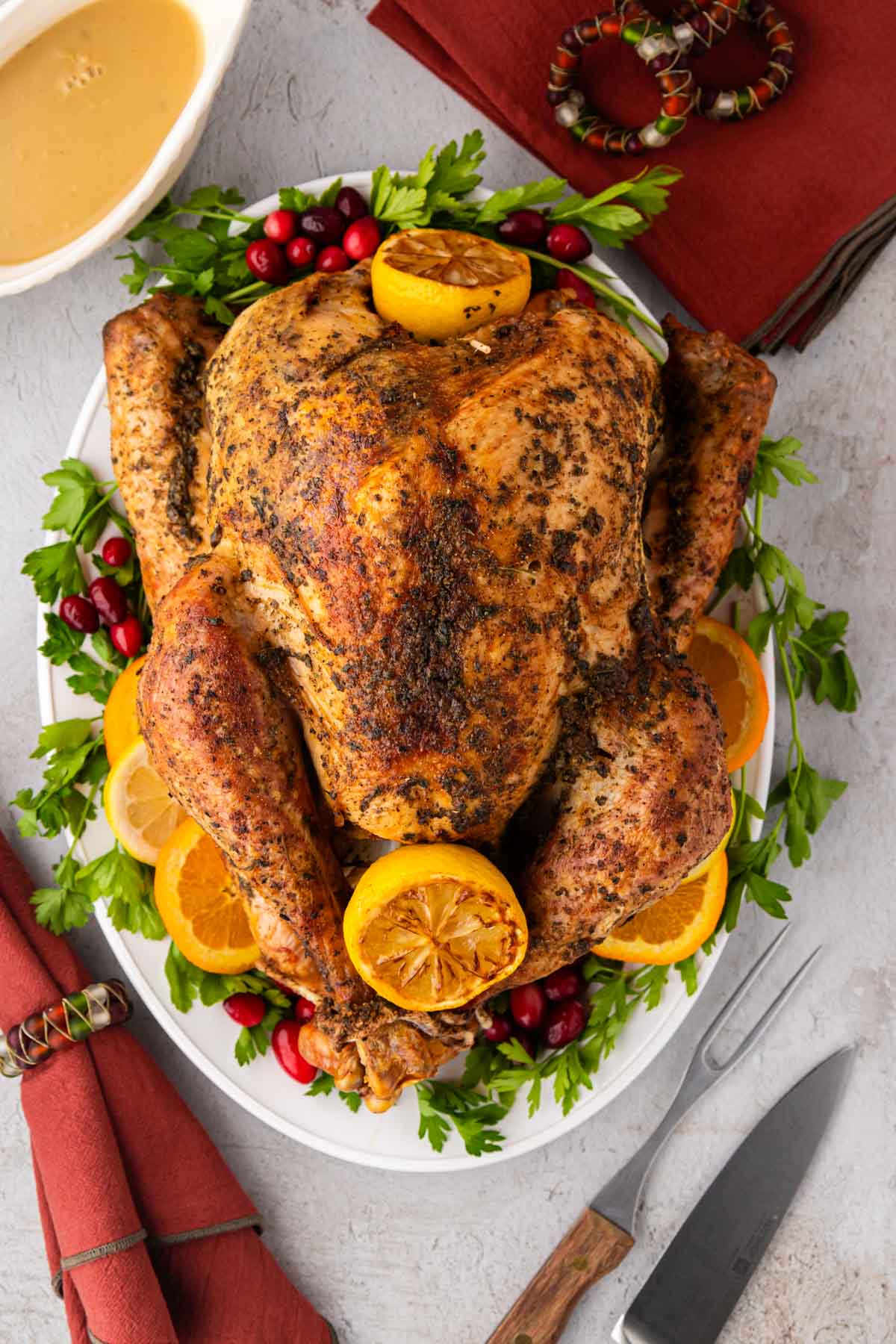
Using an Electric Roasting Oven to Cook Turkey
Follow the exact cooking instructions in this recipe. You will place the turkey in the roasting pan on a rack or use the same methods as you would in a disposable pan.
Cooking a Turkey in a Convection Oven
Use the same method, but check the turkey’s temperature earlier (start around 2 hours) since it cooks faster in a convection oven.
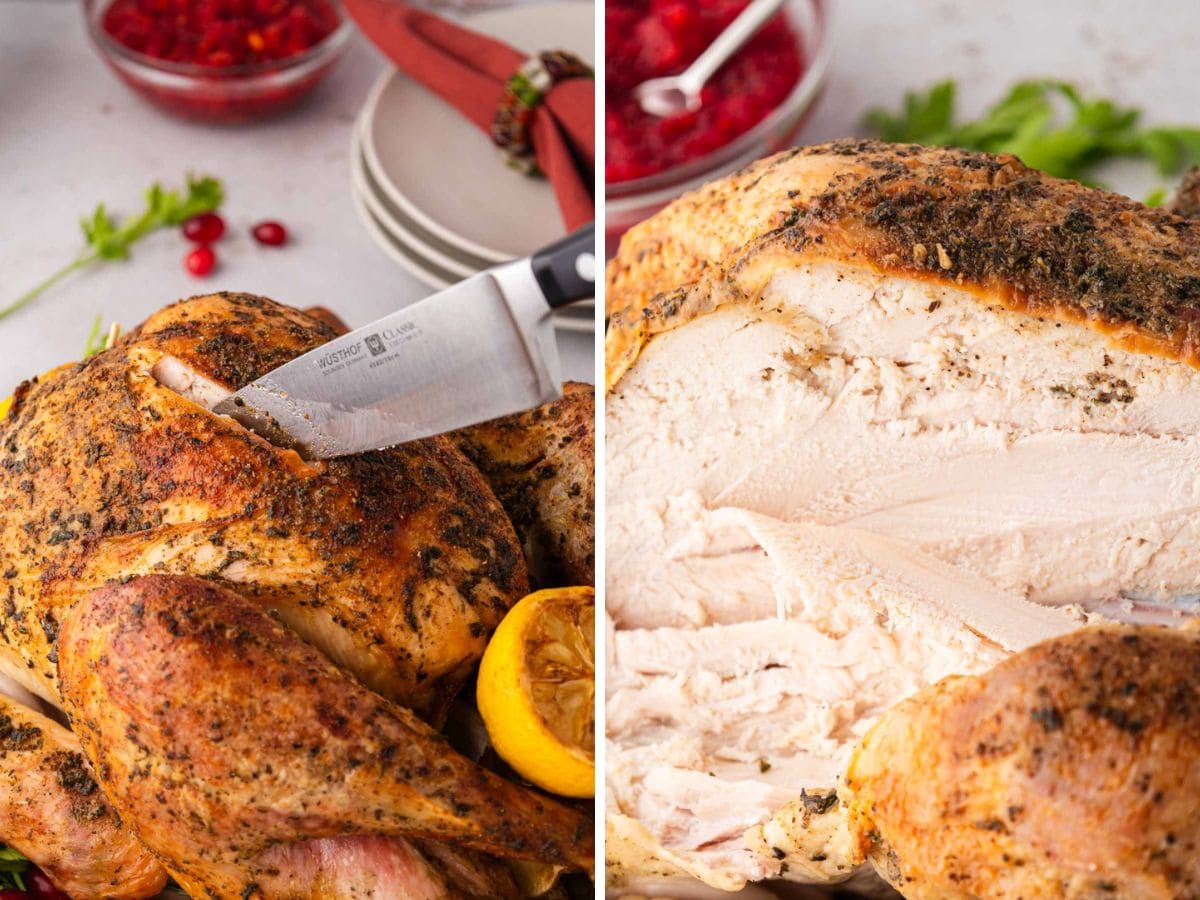
Recipe FAQs
Some people suggest roasting the turkey breast side down for the first 30-45 minutes to help keep the breast meat juicy. I don’t find it necessary. Cooking the breast side up also produces a much prettier presentation.
It’s not necessary to add water to the bottom of the roasting pan. Adding too much water will steam the turkey, which can prevent the skin from getting crispy. Instead, rely on the turkey’s natural juices and fat to create delicious drippings for gravy. I add just a cup of water for extra moisture while maintaining a crispy skin.
Roast your turkey at 325°F for even cooking and to prevent it from drying out.
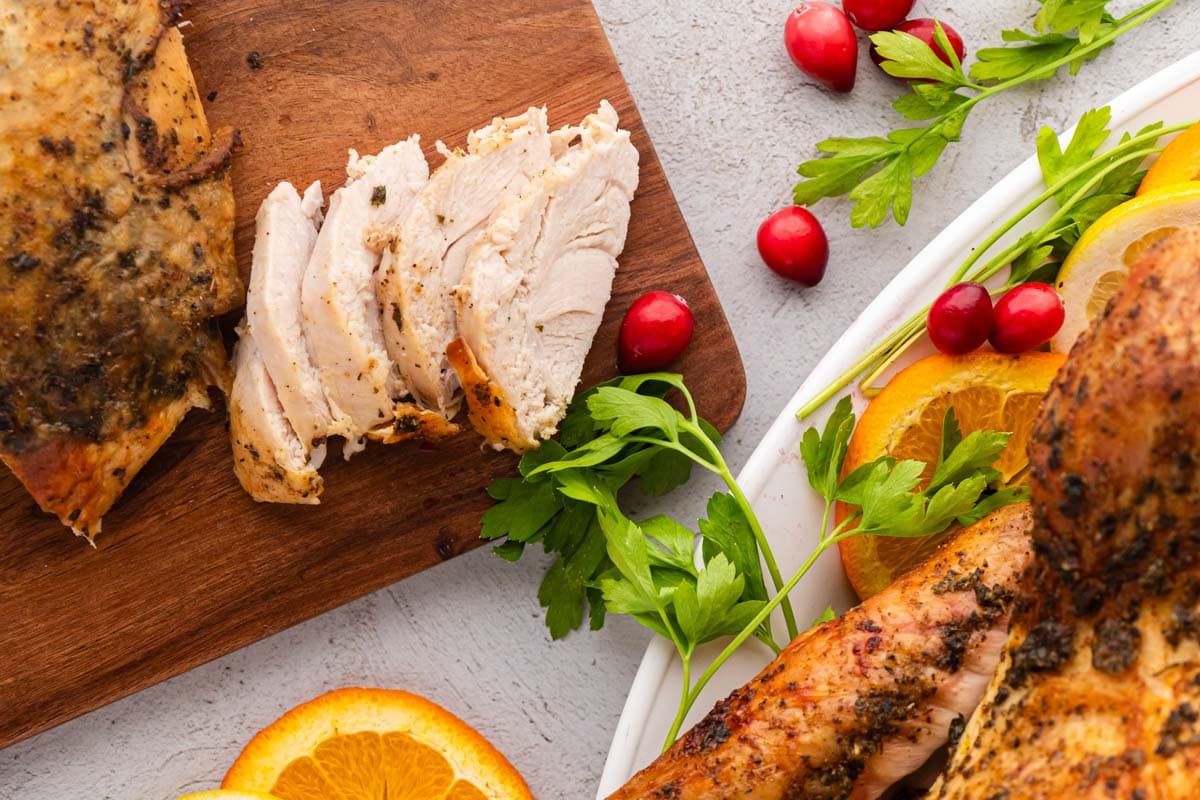
Make Ahead Instructions for Turkey
Make-Ahead: While I recommend freshly roasting the turkey for the most moist results, you can roast it a day ahead if necessary. Reheat it in a preheated 325°F oven, covered with foil, with a splash of broth or drippings to keep it as moist as possible.
Leftover Turkey Storage Instructions
Storage: After your meal, let the turkey cool completely before slicing. Store the meat in airtight containers in the fridge for up to 4 days.
How to Freeze Leftover Turkey
Freeze leftover turkey in freezer-safe bags or containers, removing as much air as possible to avoid freezer burn. For optimal flavor, it’s best consumed within 2 months. Reheat after thawing in the fridge.
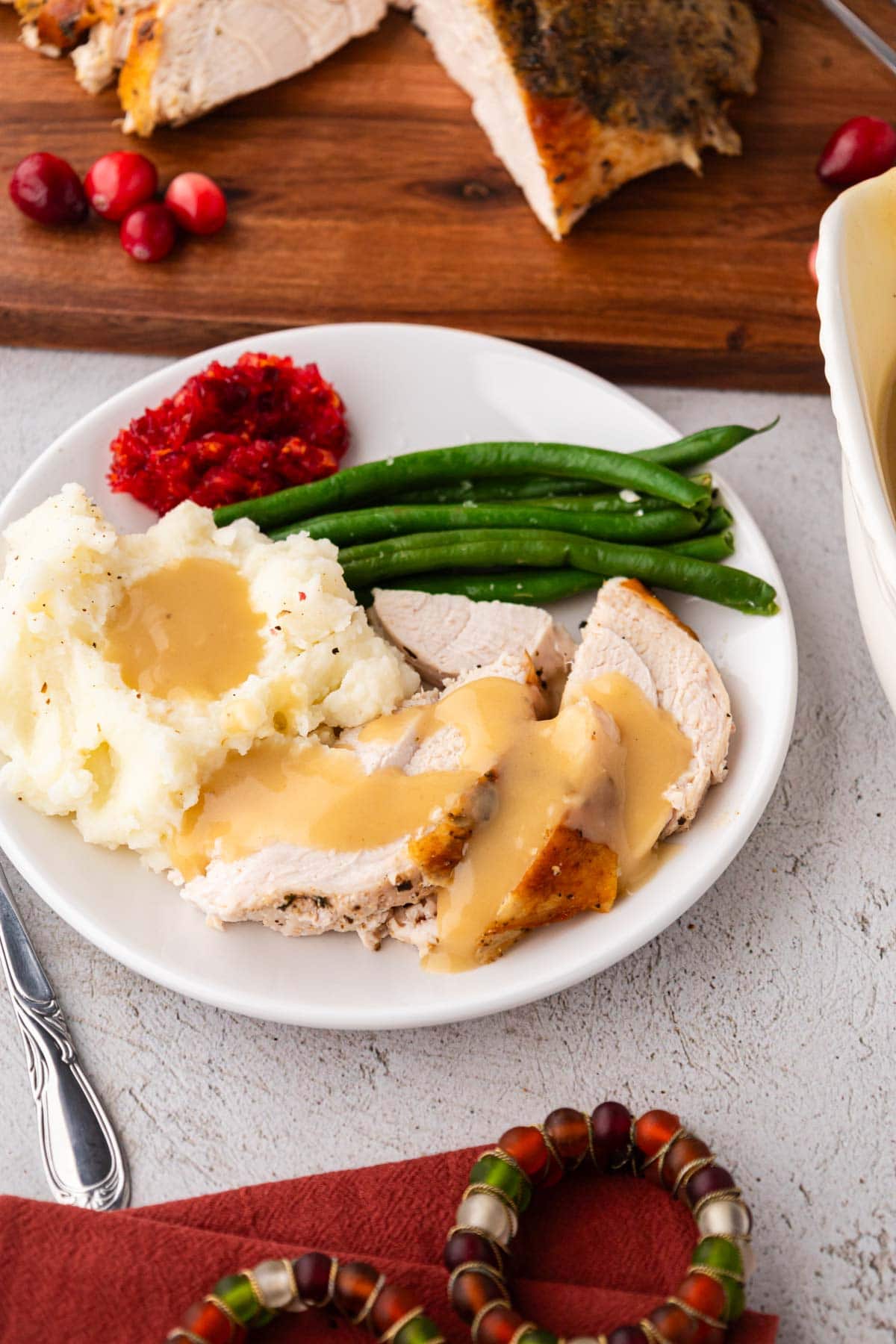
What to Serve with Thanksgiving Turkey
Our Thanksgiving menu offers many options, traditional sides, and desserts. Below are a few ideas. For more Holiday meal ideas, visit our Thanksgiving or Christmas pages to complete the menu. And don’t forget the Homemade Turkey Gravy to top off your turkey!
Hungry for more easy, home-cooked, delicious recipes?
Sign up for my free recipe club to get family-friendly recipes in your inbox each week! Find me sharing daily meal-time inspiration on Pinterest, Facebook, and Instagram.
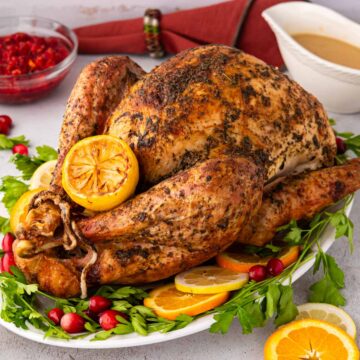
Best Roasted Turkey Recipe
Ingredients
- 12- 14 pound fresh or frozen turkey, thawed
Turkey Rub
- 1 Tablespoon kosher salt
- 2 teaspoons seasoned salt
- 1 teaspoon ground pepper
- 1 teaspoon poultry seasoning
- 1 teaspoon garlic powder
- 1 teaspoon paprika
- 1 teaspoon ground red pepper, cayenne pepper, optional or to taste
- 1 teaspoon dried basil
- 1 teaspoon dried parsley
- 1 stick of butter, softened
Optional Ingredients
- 1 – 2 lemons, quartered and placed inside cavity
- 1 large onion, quartered and placed inside cavity
Instructions
- If the turkey is frozen: Thaw in the fridge, 24 hours for every 5 pounds of Turkey. I like to give myself 1 extra day, just to be safe.
- Remove the thawed turkey from the fridge approximately 1 hour before roasting, to let it come to room temperature.
- Adjust your oven rack so the turkey will sit in the center of the oven. Preheat the oven to 325 degrees F.
- Remove the turkey from the packaging and remove the neck and giblets from the inside of the cavity of the bird. (Reserve them for gravy, if desired, or discard them). Drain the juices and pat the turkey dry with paper towels.
- Mix the seasonings together.
- Tie the legs together with heavy kitchen string. Lift the wing tips up and over the back; tuck under the turkey. Set turkey on the rack in a roasting pan.
- Use your fingers to separate the skin from the breast meat, starting at the top of the breast and sliding to the right and left, then working down. Massage ⅓ of the rub onto the meat under the skin.
- Microwave the butter for 30 seconds (it doesn’t need to be completely melted, just really softened). Mix the remaining seasoning with the butter. Use a basting brush to brush the remaining seasoned butter all over the outside of the turkey, legs, and wings.(This can also be done by mixing seasoning into softened butter and spreading on by hand)
- Insert an oven-safe meat thermometer deep into the lower part of the thigh without touching the bone.
- Roast at 325 degrees F for about 15-18 minutes per pound or until the internal temperature inserted into the thickest part of the thigh reaches about 165℉.
- Check the turkey about halfway through cooking, and once the skin gets desired golden brown, cover the top of the turkey with foil, to protect the breast meat from overcooking.
- Transfer the turkey to a platter to rest for 20 to 30 minutes before carving.
- Reserve any juices and drippings in the roasting pan to make turkey gravy.
Want to Save this Recipe?
By submitting this form, you consent to receive emails from Soulfully Made.
Notes
Turkey Roasting Tips
- Don’t Baste the Turkey: Basting requires opening the oven often, which lowers the temperature and increases cooking time. Rub the turkey with herb butter instead for a juicy, crispy skin without the hassle.
- Don’t Stuff the Turkey: Cooking stuffing inside extends the turkey’s cooking time, potentially drying out the meat. Make the stuffing separately to ensure both the turkey and stuffing cook evenly.
- No need to Brine the Turkey. For this simpler method, skip the brine and use our flavorful seasoned herb butter rub on the skin and under it for moisture and flavor without the extra step of brining.
- Covering with Foil: Start by roasting the turkey uncovered. Once the skin turns golden brown, loosely tent it with foil to prevent over-browning and over-cooking the breast meat. If you have a roasting pan with a lid, you can use that instead.
- Test with a Thermometer: To prevent overcooking, use a meat probe thermometer or an instant-read thermometer to check the internal temperature. The thickest part of the thigh should reach 165°F, ensuring safe and juicy meat. I know most turkeys have a probe that pops out, and if you don’t have a thermometer, you can use this, but I still like to use my thermometer to test it.
- Let the Turkey Rest: After cooking, let the turkey rest for at least 20-30 minutes. This allows the juices to redistribute, keeping the meat moist and tender.
- Save Turkey Drippings for Gravy: The flavorful drippings in the roasting pan are perfect for making a rich, savory turkey gravy. Strain the drippings, make a roux, and whisk in broth for an easy, delicious gravy.
Nutrition Information
Nutritional Disclaimer
Soulfully Made is not a dietician or nutritionist, and any nutritional information shared is only an estimate. We recommend running the ingredients through an online nutritional calculator if you need to verify any information.
©️Soulfully Made




